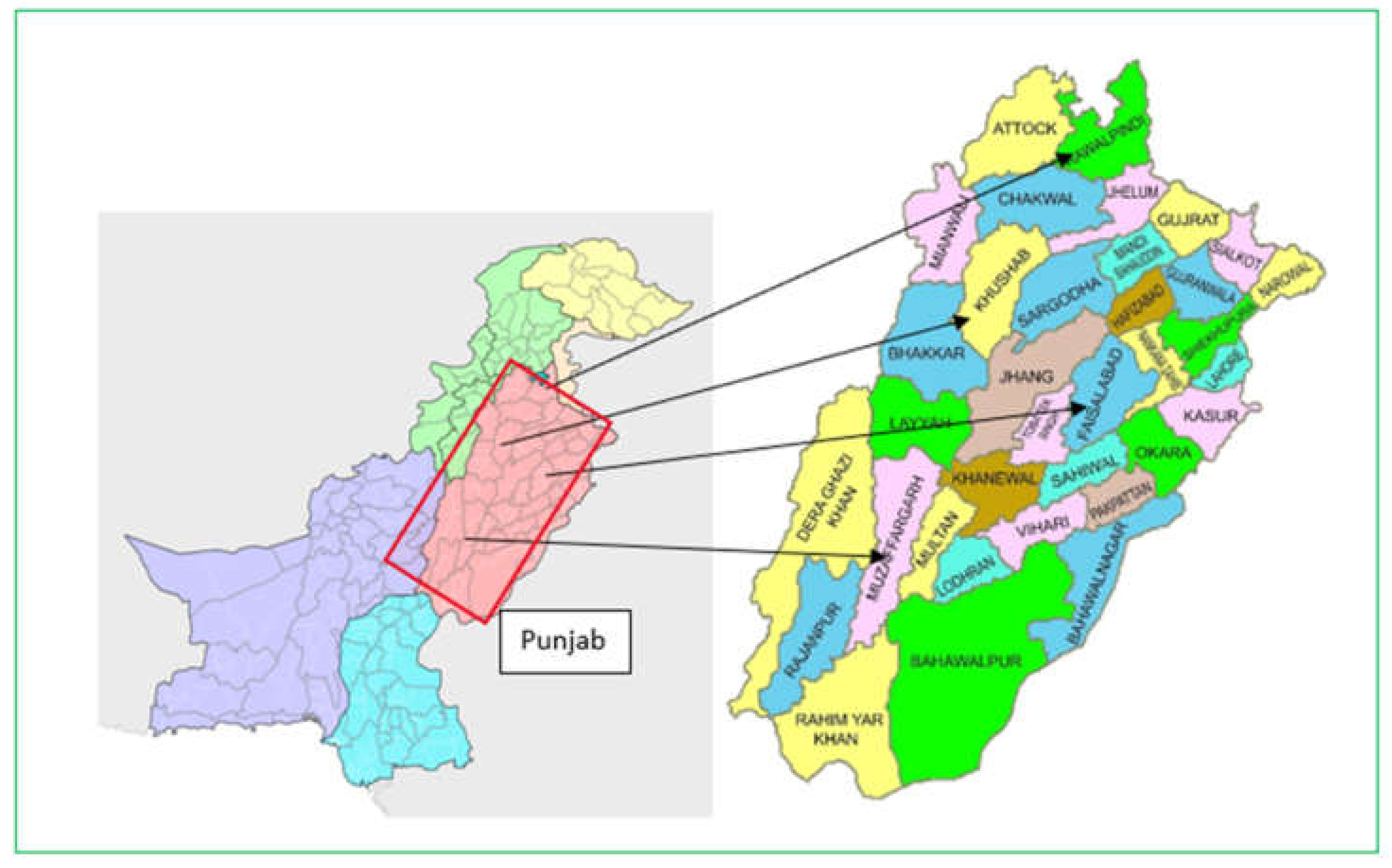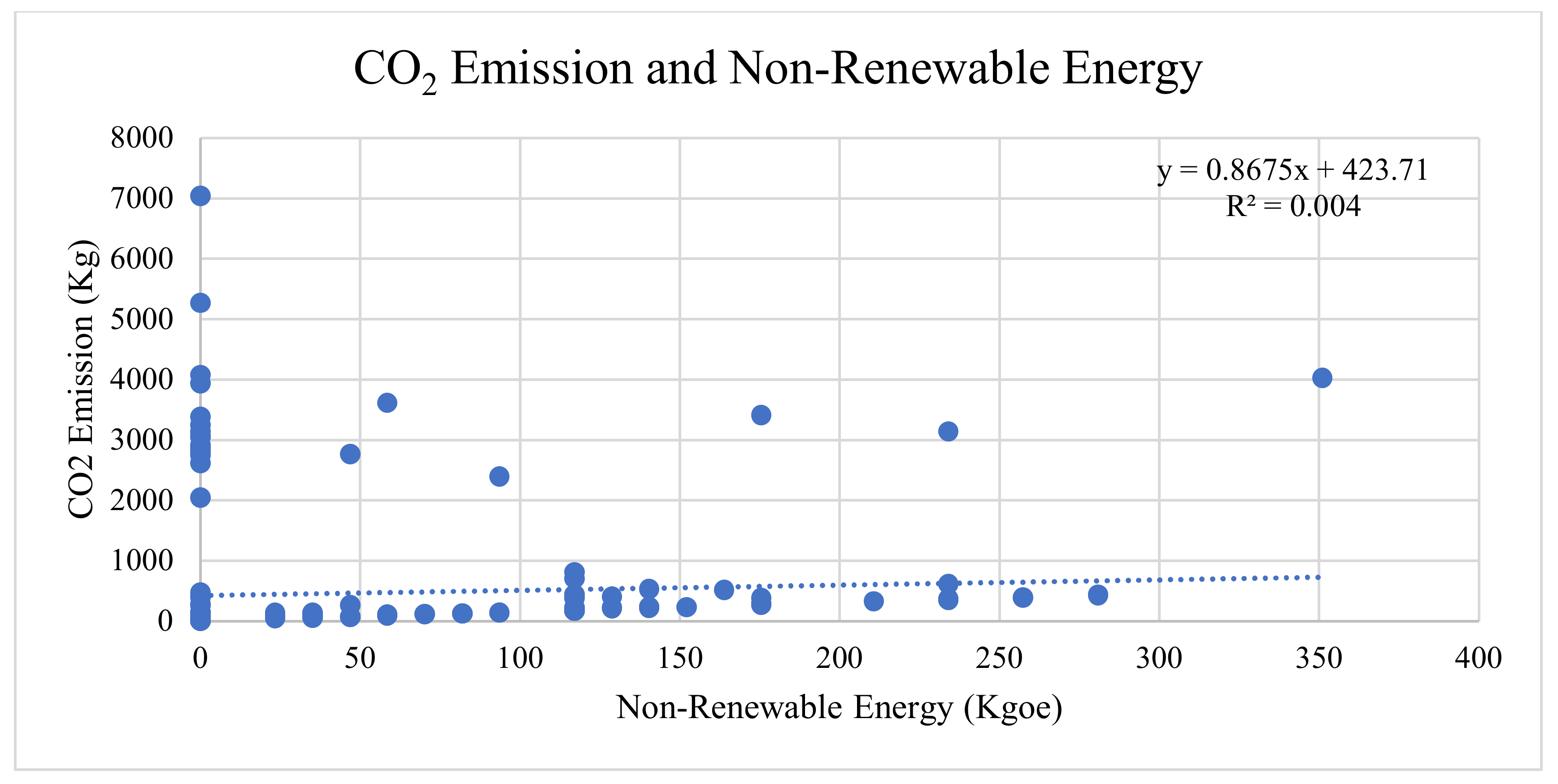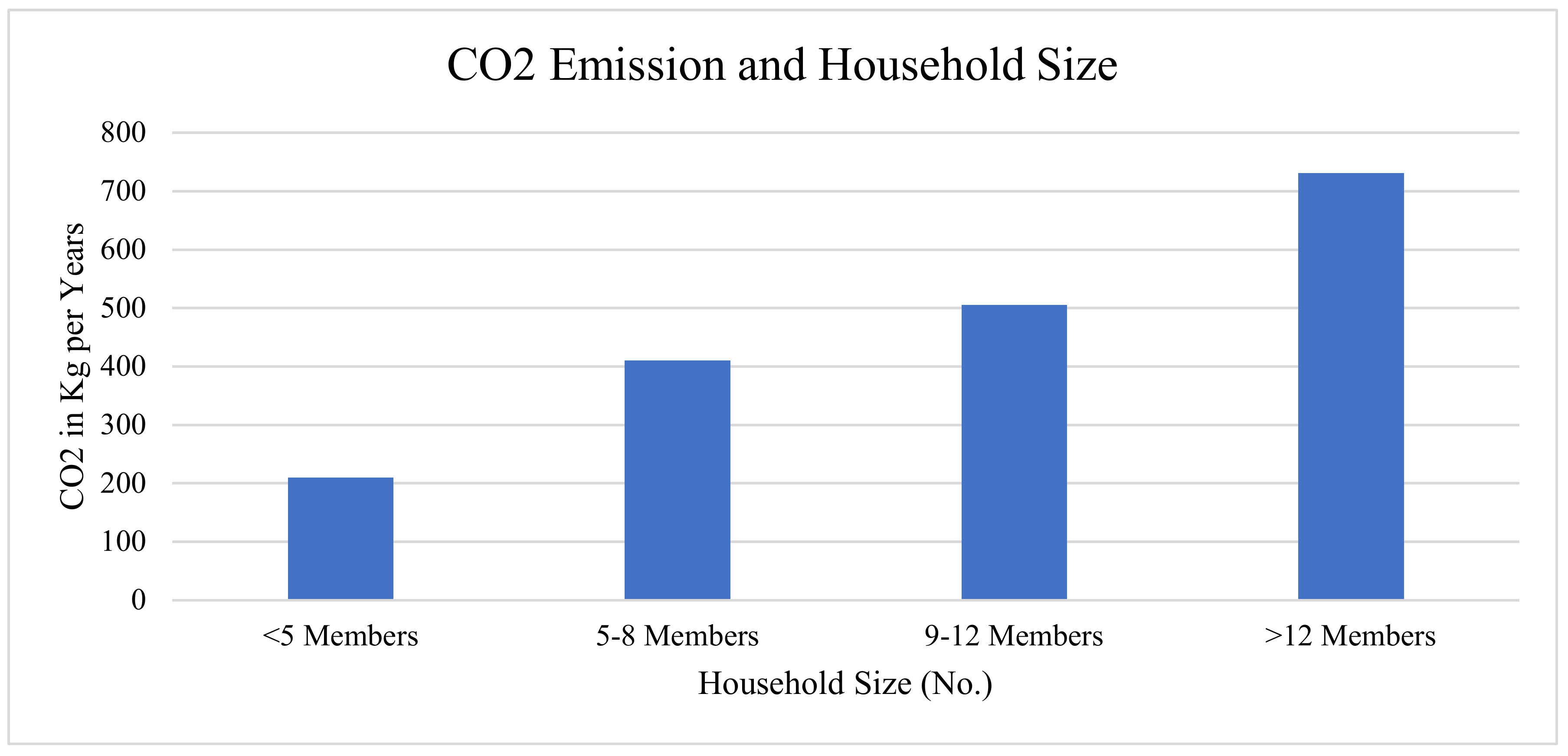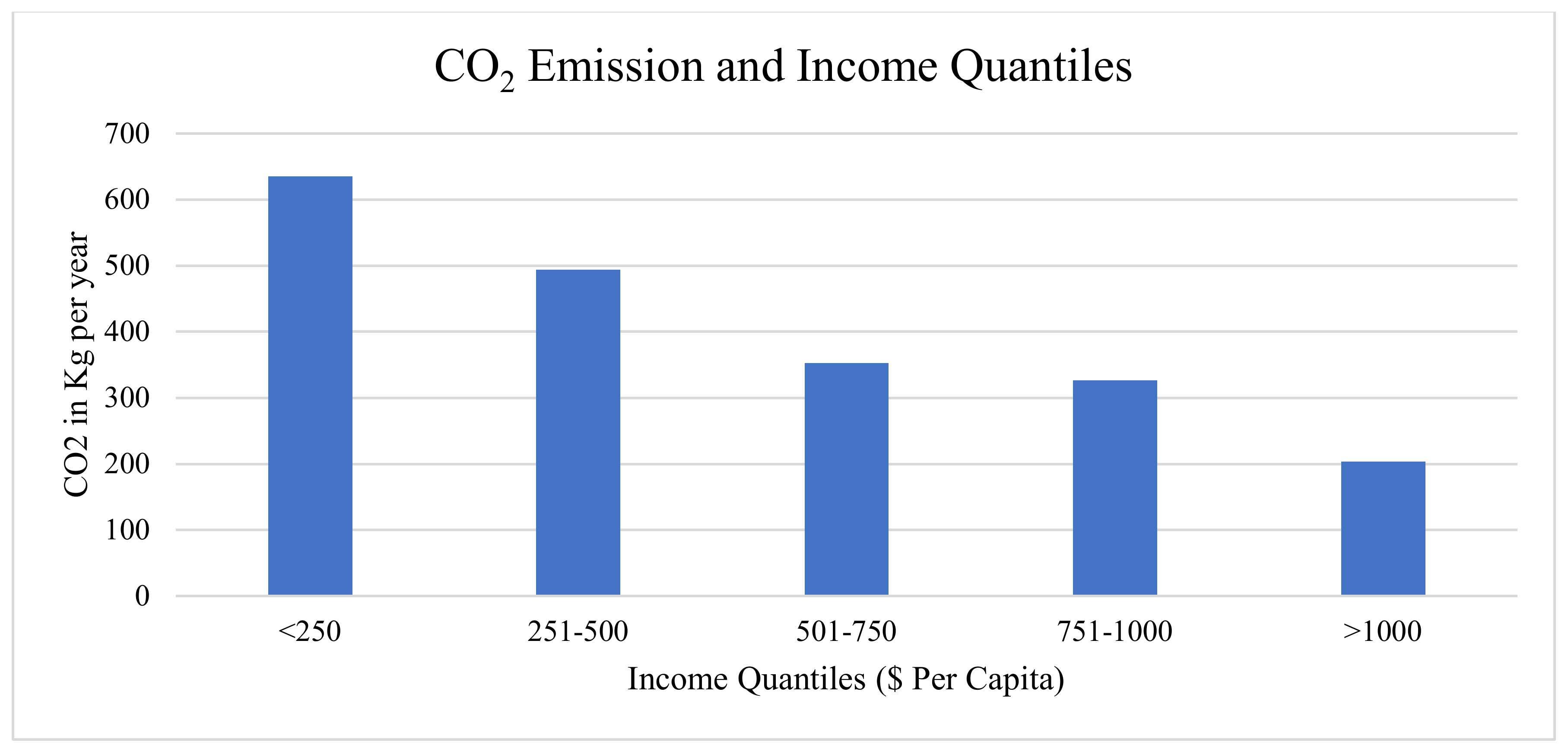Relationship between Household Dynamics, Biomass Consumption, and Carbon Emissions in Pakistan
Abstract
1. Introduction
2. Theoretical or Conceptual Framework
3. Material and Method
3.1. Study Area and Sampling
3.2. Model Specification
3.3. Energy Equivalents of Non-Renewable and Biomass Energy
4. Results and Discussion
4.1. Energy-Consumption Quantities
4.2. Association between Income, Household Size, and Energy Consumption
4.3. Association between Energy Sources and CO2 Emissions
4.4. Association between Household Size, Income, and Carbon Emissions
4.5. Results of the STIRPAT Model
5. Conclusions
Author Contributions
Funding
Informed Consent Statement
Conflicts of Interest
Abbreviations
| Kgoe | Kilogram of oil equivalent |
| GHG | Greenhouse gases |
| NRE | Non-renewable energy |
| LPG | Liquified petroleum gas |
| GDP | Gross domestic product |
| Sq. ft. | Square feet |
| Km | Kilometers |
| CEC | Carbon emission coefficient |
| IPAT | Impact population affluence technology |
| STIRPAT | Stochastic impacts by regression on population, affluence, and technology |
References
- Zhang, Y.J.; Da, Y.B. The decomposition of energy-related carbon emission and its decoupling with economic growth in China. Renew. Sustain. Energy Rev. 2015, 41, 1255–1266. [Google Scholar] [CrossRef]
- Udara Willhelm Abeydeera, L.H.; Wadu Mesthrige, J.; Samarasinghalage, T.I. Global research on carbon emissions: A scientometric review. Sustainability 2019, 11, 3972. [Google Scholar] [CrossRef]
- Olivier, J.G.J.; Schure, K.M.; Peters, J.A.H.W. Trends in Global CO2 and total Greenhouse Gas Emissions: 2017 Report. 2017. Available online: https://www.pbl.nl/sites/default/files/downloads/pbl-2017-trends-in-global-co2-and-total-greenhouse-gas-emissons-2017-report_2674.pdf (accessed on 12 December 2021).
- Druckman, A.; Jackson, T. Understanding households as drivers of carbon emissions. In Taking Stock of Industrial Ecology; Springer International Publishing: Cham, Switzerland, 2016; pp. 181–203. [Google Scholar]
- Heede, R. Tracing anthropogenic carbon dioxide and methane emissions to fossil fuel and cement producers, 1854–2010. Clim. Change 2014, 122, 229–241. [Google Scholar] [CrossRef]
- Yousaf, H.; Amin, A.; Baloch, A.; Akbar, M. Investigating household sector’s non-renewables, biomass energy consumption and carbon emissions for Pakistan. Environ. Sci. Pollut. Res. 2021, 28, 40824–40834. [Google Scholar] [CrossRef] [PubMed]
- Nejat, P.; Jomehzadeh, F.; Taheri, M.M.; Gohari, M.; Muhd, M.Z. A global review of energy consumption, CO2 emissions and policy in the residential sector (with an overview of the top ten CO2 emitting countries). Renew. Sustain. Energy Rev. 2015, 43, 843–862. [Google Scholar] [CrossRef]
- Perera, F. Pollution from fossil-fuel combustion is the leading environmental threat to global pediatric health and equity: Solutions exist. Int. J. Environ. Res. Public Health 2018, 15, 16. [Google Scholar] [CrossRef]
- Rahut, D.B.; Ali, A.; Behera, B. Domestic use of dirty energy and its effects on human health: Empirical evidence from Bhutan. Int. J. Sustain. Energy 2016, 36, 983–993. [Google Scholar] [CrossRef]
- Jan, I.; Ullah, S.; Akram, W.; Khan, N.P.; Asim, S.M.; Mahmood, Z.; Ahmad, M.N.; Ahmad, S.S. Adoption of improved cookstoves in Pakistan. A logit analysis. Biomass Bioenergy 2017, 103, 55–62. [Google Scholar] [CrossRef]
- Imran, M.; Özçatalbaş, O.; Bakhsh, K. Rural household preferences for cleaner energy sources in Pakistan. Environ. Sci. Pollut. Res. 2019, 26, 22783–22793. [Google Scholar] [CrossRef]
- Behera, S.R.; Dash, D.P. The effect of urbanization, energy consumption, and foreign direct investment on the carbon dioxide emission in the SSEA (South and Southeast Asian) region. Renew. Sustain. Energy Rev. 2017, 70, 96–106. [Google Scholar] [CrossRef]
- Fatmmi, Z.; Rahman, A.; Kazi, A.; Kadir, M.A.; Sathiakumar, N. Situational analysis of household energy and biomass use and associated health burden of indoor air pollution and mitigation efforts in Pakistan. Int. J. Environ. Res. Public Health 2010, 7, 2940–2952. [Google Scholar] [CrossRef] [PubMed]
- Parajuli, I.; Lee, H.; Shrestha, K.R. Indoor air quality and ventilation assessment of rural mountainous households of Nepal. Int. J. Sustain. Built. Environ. 2016, 5, 301–311. [Google Scholar] [CrossRef][Green Version]
- World Bank. World Bank Database. 2021. Available online: https://data.worldbank.org/ (accessed on 22 January 2022).
- Zhou, K.; Yang, S. Understanding household energy consumption behavior: The contribution of energy big data analytics. Renew. Sustain. Energy Rev. 2016, 56, 810–819. [Google Scholar] [CrossRef]
- Steg, L.; Dreijerink, L.; Abrahamse, W. Factors influencing the acceptability of energy policies: A test of VBN theory. J. Environ. Psychol. 2005, 25, 415–425. [Google Scholar] [CrossRef]
- Elster, J. Rational Choice; New York University Press: New York, NY, USA, 1986. [Google Scholar]
- Homans, G.C. Social Behavior: Its Elementary Forms; Routledge and Kegan Paul: London, UK, 1961. [Google Scholar]
- Simon, H.A. A behavioral model of rational choice. Q. J. Econ. 1955, 69, 99–118. [Google Scholar] [CrossRef]
- Payne, J.E.; Taylor, J.P. Nuclear energy consumption and economic growth in the U.S.: An empirical note. Energy Sources Part B Econ. Plan. Policy 2010, 5, 301–307. [Google Scholar] [CrossRef]
- Campbell, B.M.; Vermeulen, S.J.; Mangono, J.J.; Mabugu, R. The energy transition in action: Urban domestic fuel choices in a changing Zimbabwe. Energy Pol. 2003, 31, 553–562. [Google Scholar] [CrossRef]
- Heltberg, R. Factors determining household fuel choice in Guatemala. Environ. Dev. Econ. 2005, 10, 337–361. [Google Scholar] [CrossRef]
- Nansairo, A.; Patanothai, A.; Rambo, A.T.; Simaraks, S. Climbing the energy ladder or diversifying energy sources? The continuing importance of household use of biomass energy in urbanizing communities in northeast Thailand. Biomass Energy 2011, 35, 4180–4188. [Google Scholar] [CrossRef]
- Irfan, M.; Cameron, M.P.; Hassan, G. Household energy elasticities and policy implications for Pakistan. Energy Policy 2018, 113, 633–642. [Google Scholar] [CrossRef]
- Rahut, D.B.; Ali, A.; Mottaleb, K.A.; Aryal, J.P. Wealth, education and cooking-fuel choices among rural households in Pakistan. Energy Strategy Rev. 2019, 24, 236–243. [Google Scholar] [CrossRef]
- Mensah, J.T.; Adu, G. An empirical analysis of household energy choice in Ghana. Renew. Sustain. Energy Rev. 2015, 51, 1402–1411. [Google Scholar] [CrossRef]
- Azam, M.; Ahmed, A.M. Role of human capital and foreign direct investment in promoting economic growth: Evidence from Commonwealth of Independent States. Int. J. Soc. Econ. 2015, 42, 98–111. [Google Scholar] [CrossRef]
- Damette, O.; Delacote, P.; Del Lo, G. Households energy consumption and transition toward cleaner energy sources. Energy Policy 2018, 113, 751–764. [Google Scholar] [CrossRef]
- Huebner, G.; Shipworth, D.; Hamilton, I.; Chalabi, Z.; Oreszczyn, T. Understanding electricity consumption: A comparative contribution of building factors, socio-demographics, appliances, behaviours and attitudes. Appl. Energy 2016, 177, 692–702. [Google Scholar] [CrossRef]
- Wang, Q.; Yang, X. Urbanization impact on residential energy consumption in China: The roles of income, urbanization level, and urban density. Environ. Sci. Pollut. Res. 2019, 26, 3542–3555. [Google Scholar] [CrossRef]
- Anser, M.K. Impact of energy consumption and human activities on carbon emissions in Pakistan: Application of STIRPAT model. Environ. Sci. Pollut. Res. 2019, 26, 13453–13463. [Google Scholar] [CrossRef]
- Zhou, A.; Li, J. The nonlinear impact of industrial restructuring on economic growth and carbon dioxide emissions: A panel threshold regression approach. Environ. Sci. Pollut. Res. 2020, 27, 14108–14123. [Google Scholar] [CrossRef]
- Ehrlich, P.M.; Holdren, J.P. Impact of population growth. Am. Assoc. Advan. Sci. 1971, 70, 1657–1664. [Google Scholar]
- Dietz, T.; Rosa, E.A.; York, R. Driving the human ecological footprint. Front. Ecol. Environ. 2007, 5, 13–18. [Google Scholar] [CrossRef]
- Zhang, L.X.; Wang, C.B.; Bahaj, A.S. Carbon emissions by rural energy in China. Renew. Energy 2014, 66, 641–649. [Google Scholar] [CrossRef]
- Baul, T.K.; Datta, D.; Alam, A. A comparative study on household level energy consumption and related emissions from renewable (biomass) and non-renewable energy sources in Bangladesh. Energy Policy 2018, 114, 598–608. [Google Scholar] [CrossRef]
- Zhou, Y.; Liu, Y.S.; Wu, W.X.; Li, Y.R. Effects of rural–urban development transformation on energy consumption and CO
2 emissions: A regional analysis in China. Renew. Sustain. Energy Rev. 2015, 52, 863–875. [Google Scholar] [CrossRef] - Wang, X.; Li, K.; Li, H.; Bai, D.; Liu, J. Research on China’s rural household energy consumption–Household investigation of typical counties in 8 economic zones. Renew. Sustain. Energy Rev. 2017, 68, 28–32. [Google Scholar]
- Pokharel, S. An econometric analysis of energy consumption in Nepal. Energy Policy 2007, 35, 350–361. [Google Scholar] [CrossRef]
- Karekezi, S.; Kithyoma, W. Renewable energy strategies for rural Africa: Is a PVled renewable energy strategy the right approach for providing modern energy to the rural poor of sub Saharan Africa? Energy Policy 2002, 30, 1071–1086. [Google Scholar] [CrossRef]
- Wu, S.; Zheng, X.; You, C.; Wei, C. Household energy consumption in rural China: Historical development, present pattern and policy implication. J. Clean Prod. 2019, 211, 981–991. [Google Scholar] [CrossRef]
- Cai, J.; Jiang, Z. Changing of energy consumption patterns from rural households to urban households in China: An example from Shaanxi Province, China. Renew. Sustain. Energy Rev. 2008, 12, 1667–1680. [Google Scholar] [CrossRef]
- Tonooka, Y.; Liu, J.; Kondou, Y.; Ning, Y.; Fukasawa, O. A survey on energy consumption in rural households in the fringes of Xian city. Energy Build. 2006, 38, 1335–1342. [Google Scholar] [CrossRef]
- Zou, B.; Luo, B. Rural household energy consumption characteristics and determinants in China. Energy 2019, 182, 814–823. [Google Scholar] [CrossRef]
- Poortinga, W.; Steg, L.; Vlek, C. Values, environmental concern and environmental behavior: A study into household energy use. Environ. Behav. 2004, 36, 70–93. [Google Scholar] [CrossRef]
- Nair, G.; Gustavsson, L.; Mahapatra, K. Factors influencing energy efficiency investments in existing Swedish residential buildings. Energy Policy 2010, 38, 2956–2963. [Google Scholar] [CrossRef]
- Behera, B.; Jeetendra, A.; Ali, A. Household collection and use of biomass energy sources in South Asia. Energy 2015, 85, 468–480. [Google Scholar] [CrossRef]







| LnAge | Age of the household head was measured in years and then logarithm was performed according to STIRPAT modeling |
| Education | Education of household head was measured in years then logarithm was performed according to STIRPAT modeling |
| LnIncome | Total income (rupees) was incorporated for income effect upon energy-consumption choices, and logarithm was prformed for income elasticity and STIRPAT modeling |
| House type | Ordinal: Single family detached = 1, single family attached = 2, and other = 3 |
| Ln housing unit size | Housing unit size was measured in Sq. ft and then logarithm was performed according to STIRPAT modeling |
| Ln no. of rooms | Rooms in a house were measured in numbers and then logarithm was performed according to STIRPAT modeling |
| Ln distance from LPG Market | Distance form LPG market was measured in Km and then logarithm was performed according to STIRPAT modeling |
| Fuelwood market in village | Dummy: 1 for availability of fuelwood market in village, otherwise 0 |
| Info. about modernized cookstoves | Dummy: 1 for having information about the modern cookstove, otherwise 0 |
| Info. about clean energy | Dummy: 1 for having information about clean energy, otherwise 0 |
| Info. about fuel’s impact on environment | Dummy: 1 for having information about the impact of fuels on environment, otherwise 0 |
| Info. about health impact of biomass | Dummy: 1 for having information about the health impact of biomass, otherwise 0 |
| Use of any clean enrgy source | Dummy: 1 for using clean energy in the house, otherwise 0 |
| Ln own land | Land was measured in Acres and then logarithm was performed according to STIRPAT modeling |
| Lnlivestock | Livestock was measured in numbers and then logarithm was performed according to STIRPAT modeling |
| Primary factor for choosing any fuel type | 1 for convenience, 2 for efficiency, and 3 for price |
| Source of fuelwood | 1 for “collecting from own land”, 2 for “collecting form others’ land”, and 3 for “purchased form market” |
| Biomass Fuel Type | Energy Equivalents (Kgoe) | Emission Coefficients (t CO2/t Fuel) | Non-Renewable-Energy Type | Energy Equivalents (KGOE) | Emission Coefficients (t CO2/t Fuel) |
|---|---|---|---|---|---|
| Crop residues (kg) | 0.023 | 1.174 * | LPG | 11.7 | 0.401 |
| Fuelwood (kg) | 0.3 | 0.03 | |||
| Dung cake (kg) | 2.16 | 0.787 * |
| Energy Source | Physical Quantity of Consumption per Month | Coefficient of Kilogram of Oil Equivalent (Kgoe) | Consumption (Kgoe/Month) | Percent of Total Consumption |
|---|---|---|---|---|
| LPG (kg) | 10.72 | 11.70 | 125.42 | 24.22 |
| Fuelwood (kg) | 296.93 | 0.30 | 89.08 | 17.20 |
| Crop residual (kg) | 446.25 | 0.02 | 10.26 | 1.98 |
| Dung cake (kg) | 93.76 | 2.16 | 202.52 | 39.11 |
| Natural gas (MMBTU) | 3.27 | 25.00 | 81.75 | 15.79 |
| Electricity (kwh) | 103.42 | 0.09 | 8.79 | 1.70 |
| Variables | Non-Renewable Energy | Biomass |
|---|---|---|
| Coef. (Std. Error) | Coef. (Std. Error) | |
| Constant | −53.065 | 48.621 |
| (26.146) | (36.650) | |
| LnAge | −0.150 | 0.282 |
| (0.341) | (0.478) | |
| Education | 3.216 * | −8.231 * |
| (1.093) | (2.345) | |
| LnIncome | 0.010 * | −0.012 * |
| (0.002) | (0.001) | |
| Ln housing unit size | −0.004 * | 0.005 ** |
| (0.002) | (0.003) | |
| Ln distance from LPG market | −1.621 * | 1.082 *** |
| (0.464) | (0.651) | |
| Fuelwood market in village | 6.477 | 17.964 * |
| (8.281) | (6.567) | |
| Info. about modernized cookstoves | −4.636 * | −4.628 * |
| (1.365) | (1.098) | |
| Info. about clean energy | −12.237 * | −4.112 * |
| (3.276) | (0.987) | |
| Info. about fuel’s impact on environment | −2.602 ** | −7.071 * |
| (1.004) | (0.789) | |
| Info. about health impact of biomass | 2.380 * | −4.702 * |
| (0.684) | (1.009) | |
| Use of any clean energy source | −26.096 * | −20.243 *** |
| (8.062) | (11.301) | |
| Ln own land | −0.801 | 1.597 |
| (0.790) | (1.108) | |
| Lnlivestock | −0.105 ** | 0.053 * |
| (0.057) | (0.012) | |
| Primary factor for choosing any fuel type | −0.293 * | 0.267 * |
| (0.064) | (0.099) | |
| Source of fuelwood | 10.585 * | −5.267 * |
| (2.586) | (1.056) |
Publisher’s Note: MDPI stays neutral with regard to jurisdictional claims in published maps and institutional affiliations. |
© 2022 by the authors. Licensee MDPI, Basel, Switzerland. This article is an open access article distributed under the terms and conditions of the Creative Commons Attribution (CC BY) license (https://creativecommons.org/licenses/by/4.0/).
Share and Cite
Imran, M.; Zahid, A.; Mouneer, S.; Özçatalbaş, O.; Ul Haq, S.; Shahbaz, P.; Muzammil, M.; Murtaza, M.R. Relationship between Household Dynamics, Biomass Consumption, and Carbon Emissions in Pakistan. Sustainability 2022, 14, 6762. https://doi.org/10.3390/su14116762
Imran M, Zahid A, Mouneer S, Özçatalbaş O, Ul Haq S, Shahbaz P, Muzammil M, Murtaza MR. Relationship between Household Dynamics, Biomass Consumption, and Carbon Emissions in Pakistan. Sustainability. 2022; 14(11):6762. https://doi.org/10.3390/su14116762
Chicago/Turabian StyleImran, Muhammad, Azlan Zahid, Salma Mouneer, Orhan Özçatalbaş, Shamsheer Ul Haq, Pomi Shahbaz, Muhammad Muzammil, and Muhammad Ramiz Murtaza. 2022. "Relationship between Household Dynamics, Biomass Consumption, and Carbon Emissions in Pakistan" Sustainability 14, no. 11: 6762. https://doi.org/10.3390/su14116762
APA StyleImran, M., Zahid, A., Mouneer, S., Özçatalbaş, O., Ul Haq, S., Shahbaz, P., Muzammil, M., & Murtaza, M. R. (2022). Relationship between Household Dynamics, Biomass Consumption, and Carbon Emissions in Pakistan. Sustainability, 14(11), 6762. https://doi.org/10.3390/su14116762








